
Publisher:
Bonnie King
CONTACT:
Newsroom@Salem-news.com
Advertising:
Adsales@Salem-news.com

~Truth~
~Justice~
~Peace~
TJP
Jan-28-2011 01:50

 TweetFollow @OregonNews
TweetFollow @OregonNews
The Sands of Bayocean
JD Adams Salem-News.comThe story of Bayocean is one of ruthless ambition and human folly amid the seductive beauty of the Oregon Coast.
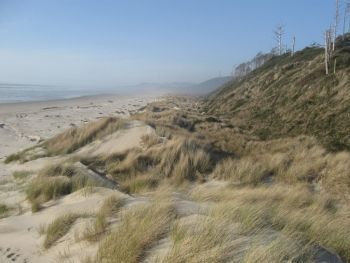 Bayocean in the present day. Salem-News.com photo by Bonnie King |
(SALEM, Ore.) - Bayocean - the name evokes an inviting duality of the rolling sea and a paradise sheltered from storms, where the blue sky is painted with soft clouds that drift across the horizon like daydreams.
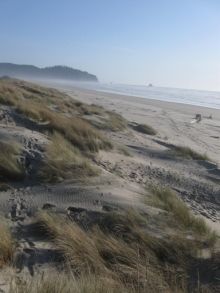 Bayocean image by Bonnie King |
And so it was for many years for those who thought life there would be idyllic, nestled into the uncrowded beach of the Tillamook Peninsula.
The amenities that graced Bayocean were many, and gave it the luxurious ambiance of a posh resort befitting the populous East Coast. It was a post card setting almost unbelievable compared to the other communities of the Oregon Coast that were still struggling to acquire basic utilities during this time.
There were neat concrete streets with streetlights, a railroad, a yacht that brought in wide-eyed tourists as prospective purchasers of property, and a fine indoor swimming pool with a wave machine.
There was a school, three hotels, a grocery store, and a good supply of water was piped in. The lots sold well, and for a time the elite settled like gaudy birds of paradise amid the sand and surf of Bayocean.
Today, there is only a trail winding through the former site, and the sound of the wind. The area is frequented by hikers, mountain bikers, and equestrians. Most of the buildings were washed away in the 50s. What befell this singular town, once billed as the Atlantic City of the West?
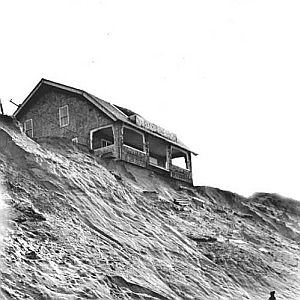 |
A few stubborn souls clung to the dream of Bayocean long after most of the residents had evacuated, surrounded by dwindling rubble and with the sound of the waves growing ever closer. With each tidal surge the sea reclaimed more sand of the once-substantial peninsula, until it was breached and became an island.
The story of Bayocean is one of ruthless ambition and human folly amid the seductive beauty of the Oregon Coast, one that is destined to be repeated at other sites.
Bayocean's Rapid Erosion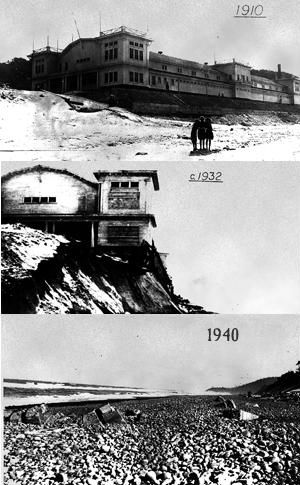 This dramatic sequence of photos from the resort community of Bayocean, near Cape Meares, illustrates the chronic effects of beach erosion. Courtesy: Oregon Dept. of Geology and Mineral Industries |
The site of Bayocean was allegedly determined by where a goose that had been shot by Thomas Irving Potter plummeted to the beach during a boating excursion in Tillamook Bay. Did this fallen bird become a talisman of doom for the future of Bayocean?
Thomas Irving was the son of wealthy real estate baron Thomas Benton Potter. Once informed of the potential of the site, the elder Potter chose the name and immediately set about planning it's construction. The original Tillamook Peninsula was four miles in length, and about a quarter mile to half a mile wide. A knoll over 100 feet high occupied the center, crowned by windswept trees.
The ambitious father and son team realized that several obstacles to success stood in their way, mainly that of promotion, transportation, and obtaining a water supply. They hired an engineer by the name of C.E. Lockwood who was involved in platting the town and designing the water system.
The end product was a clever gravity-fed arrangement with a source at Coleman Creek on Cape Meares. The spring water was carried through tar-covered wooden pipes to the neck of the peninsula and alongside the bay to the townsite, and had enough pressure to serve houses up on the knoll.
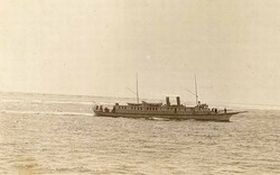 The ship that brought people to Bayocean |
In the early years a man by the name of Swan Hawkinson maintained the water system, followed by Russell E. Hoover, and later by Louis Bennet, a carpenter who worked on the huge wooden blimp hangers near Tillamook. As of 1989 some of Lockwoods original plumbing was serving the Cape Meares Community south of the peninsula.
The Potters were tireless in promoting Bayocean through brochures, sales pitches, and by working their numerous connections.
In 1906 transportation was still primitive along the Oregon Coast. T. B. Potter responded to the challenge by building his own yacht, which was completed in 1911, and at 150 ft. in length, it was the biggest motor vessel carrying passengers along Pacific Coast.
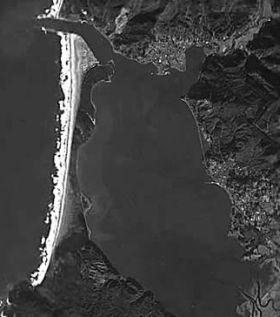 Google Earth image of Bayocean, Oregon |
The elder Potter's health had begun to fail, however, and from this point on Thomas Irving took over most of the operations. Later in 1911 the Pacific Railway and Navigation Company started running 'The Tillamook Flyer' from Hillsboro 91 miles to Bay City, where a ferry completed the journey to the site of Bayocean.
When the roads were completed, a diesel generator was purchased to provide power, a telephone system was installed, and the lots began to sell. Prices varied from $1800 to as low as $200 depending on location and utilities provided.
Pharmacist Francis Drake Mitchell was one of the first to settle in Bayocean, and he would figure prominently in its rise and fall. He constructed the Bayside Hotel that opened in 1908. The grand opening of Bayocean was June 22, 1912, complete with a brass band and fanfare that continued into the night with fireworks.
Over 1,600 lots had been sold by 1914. This was quite a feat considering that there was no road to Bayocean until 1928. A tent city had sprung up to house construction personnel and short-term vacationers, and this area came to be known as Cottage Park as more substantial houses were built.
The days at Bayocean were spent enjoying the expansive beach, surfing, clamming, and fishing for crabs. Atop Kincheloe Point and in the brushy lowlands there were rabbits that were hunted with rented .22 rifles. Many also enjoyed fishing in the bay on rented boats.
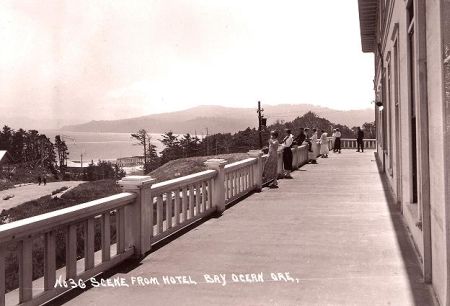 |
The Potters had been somewhat too aggressive in promoting and developing Bayocean, and their contractual responsibilities suffered for it. There were several lawsuits involving misrepresented properties or shoddy, incomplete roadways.
T. Benton Potter allegedly became ill from the stress and suddenly dashed from his house during the night and was never seen at Bayocean again.
He retired to Alameda, California by 1912, and T. Irving had sold his real estate company by 1914 to pursue other interests. The energetic glow of Bayocean slowly faded, but it lived on thanks to the enthusiasm of Francis Drake Mitchell and his wife. Their pharmacy, grocery store, hotel, and later a gas station were anchors for the community. Ironically, when a road was built in to Bayocean, vandalism caused nearly as much damage to the town as the erosion of sand.
The ultimate demise of Bayocean can be traced to a single jetty built by the Corps of Engineers to the north of Tillamook Bay from 1914 to 1917. During planning and negotiations for the project, the Corps repeatedly advised against building a single jetty, as previous studies had shown it would destabilize the movement of sand around the Tillamook Bar. However, the commissioners for the Ports of Tillamook and Bay City could not or would not pay for a second jetty.
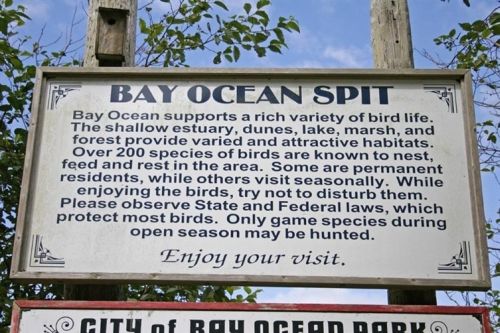 |
As early as 1920 it was observed that the peninsula and beach of Bayocean were getting narrower. Frontage property and cabins started to disappear at an alarming rate. The erosion increased after the north jetty was extended in 1933.
The ocean broke over the peninsula in 1939, 1942, 1948, and the final blow came in 1952, when the peninsula became totally isolated after a storm. Most of the residents evacuated at or before this time. The Mitchells held on until 1953. A south jetty was finally built in the early 70s, and the sand has been returning to the peninsula ever since.
As of 1982, 48 people still owned property there, but no construction is allowed. The last remnant of Bayocean were Mrs. Bennet's daffodils.
In viewing the old photos of the neighborhoods of Bayocean, one thing cannot be overemphasized - the substantial nature of the forested grottos and hillsides makes the end that came seem impossible.
To walk the trails of the peninsula today is truly a trip back in time.
Source: Bert and Margie Webber, Bayocean The Oregon Town That Fell Into the Sea; Medford, Or: Web Research Group, 1989.
 J. D. Adams was born in Salem, Oregon, a descendant of Oregon Trail pioneer William Lysander Adams. As a wilderness explorer, photographer, and writer, he sustains a kinship with the spirit of the Oregon country. JD inhabits Oregon's Silicon Forest as an electronics professional with degrees in Electronics Engineering Technology and Microelectronics.
J. D. Adams was born in Salem, Oregon, a descendant of Oregon Trail pioneer William Lysander Adams. As a wilderness explorer, photographer, and writer, he sustains a kinship with the spirit of the Oregon country. JD inhabits Oregon's Silicon Forest as an electronics professional with degrees in Electronics Engineering Technology and Microelectronics.
He maintains a Web presence with a signature presentation in genres including travel, history, and technology.
You can write to Jim Adams at this email address: j1mcm0s@earthlink.net
Also, visit Jim's Website: home.earthlink.net/~j1mcm0s/
Articles for January 27, 2011 | Articles for January 28, 2011 | Articles for January 29, 2011

Quick Links
DINING
Willamette UniversityGoudy Commons Cafe
Dine on the Queen
Willamette Queen Sternwheeler
MUST SEE SALEM
Oregon Capitol ToursCapitol History Gateway
Willamette River Ride
Willamette Queen Sternwheeler
Historic Home Tours:
Deepwood Museum
The Bush House
Gaiety Hollow Garden
AUCTIONS - APPRAISALS
Auction Masters & AppraisalsCONSTRUCTION SERVICES
Roofing and ContractingSheridan, Ore.
ONLINE SHOPPING
Special Occasion DressesAdvertise with Salem-News
Contact:AdSales@Salem-News.com


Salem-News.com:

Terms of Service | Privacy Policy
All comments and messages are approved by people and self promotional links or unacceptable comments are denied.
[Return to Top]
©2025 Salem-News.com. All opinions expressed in this article are those of the author and do not necessarily reflect those of Salem-News.com.